Oracle数据库常用语法
基本
--新建表:
create table table1( id varchar(300) primary key, name varchar(200) not null);
--插入数据
insert into table1 (id,name) values ('aa','bb');
--更新数据
update table1 set id = 'bb' where id='cc';
--删除数据
delete from table1 where id ='cc';
--删除表
drop table table1;
--修改表名:
alter table table1 rename to table2;
--表数据复制:
insert into table1 (select * from table2);
--复制表结构:
create table table1 select * from table2 where 1>1;
--复制表结构和数据:
create table table1 select * from table2;
--复制指定字段:
create table table1 as select id, name from table2 where 1>1;
--条件查询:
select id,name (case gender when 0 then '男' when 1 then ‘女’ end ) gender from table1
数学函数
--绝对值:abs()
select abs(-2) value from dual; --(2)
--取整函数(大):ceil()
select ceil(-2.001) value from dual; --(-2)
--取整函数(小):floor()
select floor(-2.001) value from dual; --(-3)
--取整函数(截取):trunc()
select trunc(-2.001) value from dual; -- (-2)
--四舍五入:round()
select round(1.234564,4) value from dual; --(1.2346)
--取平方:Power(m,n)
select power(4,2) value from dual; --(16)
--取平方根:SQRT()
select sqrt(16) value from dual; --(4)
--取随机数:dbms_random(minvalue,maxvalue)
select dbms_random.value() from dual; (默认是0到1之间)
select dbms_random.value(2,4) value from dual; (2-4之间随机数)
--取符号:Sign()
select sign(-3) value from dual; --(-1)
select sign(3) value from dual; --(1)
--取集合的最大值:greatest(value)
select greatest(-1,3,5,7,9) value from dual; --(9)
--取集合的最小值:least(value)
select least(-1,3,5,7,9) value from dual; --(-1)
--处理Null值:nvl(空值,代替值)
select nvl(null,10) value from dual; --(10)
select nvl(score,10) score from student;
rownum相关
--rownum小于某个数时可以直接作为查询条件(注意oracle不支持select top)
select * from student where rownum <3;
--查询rownum大于某个数值,需要使用子查询,并且rownum需要有别名
select * from(select rownum rn ,id,name from student) where rn>2;
select * from (select rownum rn, student.* from student) where rn >3;
--区间查询
select * from (select rownum rn, student.* from student) where rn >3 and rn<6;
--排序+前n条
select * from (select rownum rn, t.* from ( select d.* from DJDRUVER d order by drivernumber)t )p where p.rn<10;
--排序+区间查询1
select * from (select rownum rn, t.* from ( select d.* from DJDRIVER d order by DJDRIVER_DRIVERTIMES)t )p where p.rn<9 and p.rn>6;
--排序+区间查询2
select * from (select rownum rn, t.* from ( select d.* from DJDRIVER d order by DJDRIVER_DRIVERTIMES)t where rownum<9 )p where p.rn>6;--效率远高于方式一
分页查询
(假设每页显示10条)
不包含排序:
--效率低
select * from (select rownum rn, d.* from DJDRIVER d )p where p.rn<=20 and p.rn>=10;
select * from (select rownum rn, d.* from DJDRIVER d )p where p.rn between 10 and 20;
--效率高
select * from (select rownum rn, d.* from DJDRIVER d where rownum<=20 )p where p.rn>=10;
包含排序:
--排序+区间查询1(效率低)
select * from (select rownum rn, t.* from ( select d.* from DJDRIVER d order by DJDRIVER_DRIVERTIMES)t )p where p.rn<=20 and p.rn>=10;
select * from (select rownum rn, t.* from ( select d.* from DJDRIVER d order by DJDRIVER_DRIVERTIMES)t )p where p.rn between 10 and 20;
--排序+区间查询2(效率高)
select * from (select rownum rn, t.* from ( select d.* from DJDRIVER d order by DJDRIVER_DRIVERTIMES)t where rownum<=20 )p where p.rn>=10;
时间处理
1. to_char和to_date基本使用
--日期
--年 yyyy yyy yy year
--月 month mm mon month
--日+星期 dd ddd(一年中第几天) dy day
--小时 hh hh24
--分 mi
--秒 ss
eg1:
select to_char(sysdate,'yyyy-mm-dd hh24:mi:ss')currenttime,
to_char(sysdate,'yyyy') year,
to_char(sysdate,'mm') month,
to_char(sysdate,'dd') day,
to_char(sysdate,'day') week,
to_char(sysdate,'hh24')hour,
to_char(sysdate,'mi') minute,
to_char(sysdate,'ss') second
from dual;

eg2:
select to_date('2009-07-04 05:02:01','yyyy-mm-dd hh24:mi:ss')currenttime,
to_char(to_date('2009-07-04 05:02:01','yyyy-mm-dd hh24:mi:ss'),'yyyy')year,
to_char(to_date('2009-07-04 05:02:01','yyyy-mm-dd hh24:mi:ss'),'mm')month,
to_char(to_date('2009-07-04 05:02:01','yyyy-mm-dd hh24:mi:ss'),'dd') day,
to_char(to_date('2009-07-04 05:02:01','yyyy-mm-dd hh24:mi:ss'),'day') week,
to_char(to_date('2009-07-04 05:02:01','yyyy-mm-dd hh24:mi:ss'),'day','NLS_DATE_LANGUAGE=American') week, --设置语言
to_char(to_date('2009-07-04 05:02:01','yyyy-mm-dd hh24:mi:ss'),'hh24')hour,
to_char(to_date('2009-07-04 05:02:01','yyyy-mm-dd hh24:mi:ss'),'mi') minute,
to_char(to_date('2009-07-04 05:02:01','yyyy-mm-dd hh24:mi:ss'),'ss') second
from dual;

2)months_between
select months_between(to_date('03-31-2014','MM-DD-YYYY'),to_date('12-31-2013','MM-DD-YYYY')) "MONTHS"
FROM DUAL;

3)next_day
select sysdate today, next_day(sysdate,6) nextweek from dual;

4)时间区间
例:
select cardid, borrowdate from borrow where to_date(borrowdate,'yyyy-mm-dd hh24:mi:ss') between
to_date('2014-02-01 00:00:00','yyyy-mm-dd hh24:mi:ss') and
to_date('2014-05-01 00:00:00','yyyy-mm-dd hh24:mi:ss');
5)interval
select to_char(sysdate,'yyyy-mm-dd hh24:mi:ss') currenttime,
to_char(sysdate - interval '7' year,'yyyy-mm-dd hh24:mi:ss') intervalyear,
to_char(sysdate - interval '7' month,'yyyy-mm-dd hh24:mi:ss') intervalMonth,
to_char(sysdate - interval '7' day,'yyyy-mm-dd hh24:mi:ss') intervalday,
to_char(sysdate - interval '7' hour,'yyyy-mm-dd hh24:mi:ss') intervalHour,
to_char(sysdate - interval '7' minute,'yyyy-mm-dd hh24:mi:ss') intervalMinute,
to_char(sysdate - interval '7' second,'yyyy-mm-dd hh24:mi:ss') intervalSecond
from dual;

6)add_months
select add_months(sysdate,12) newtime from dual;
7)extract
select extract(month from sysdate) "This Month",
extract(year from add_months(sysdate,36)) " Years" from dual;

字符函数
--字符函数
select substr('abcdefg',1,5)substr, --字符串截取
instr('abcdefg','bc') instr, --查找子串
'Hello'||'World' concat, --连接
trim(' wish ') trim, --去前后空格
rtrim('wish ') rtrim, --去后面空格
ltrim(' wish') ltrim, --去前面空格
trim(leading 'w' from 'wish') deleteprefix, --去前缀
trim(trailing 'h' from 'wish') deletetrailing, --去后缀
trim('w' from 'wish') trim1,
ascii('A') A1,
ascii('a') A2, --ascii(转换为对应的十进制数)
chr(65) C1,
chr(97) C2, --chr(十进制转对应字符)
length('abcdefg') len, --length
lower('WISH')lower,
upper('wish')upper,
initcap('wish')initcap, --大小写变换
replace('wish1','1','youhappy') replace, --替换
translate('wish1','1','y')translate, --转换,对应一位(前面的位数大于等于后面的位数)
translate('wish1','sh1','hy')translate1,
concat('11','22') concat --连接
from dual;

to_number
--to_number(expr)
--to_number(expr,format)
--to_number(expr,format,'nls-param')
select to_number('0123')number1, --converts a string to number
trunc(to_number('0123.123'),2) number2,
to_number('120.11','999.99') number3,
to_number('0a','xx') number4, --converts a hex number to decimal
to_number(100000,'xxxxxx') number5
from dual;

聚合函数
student表如下:
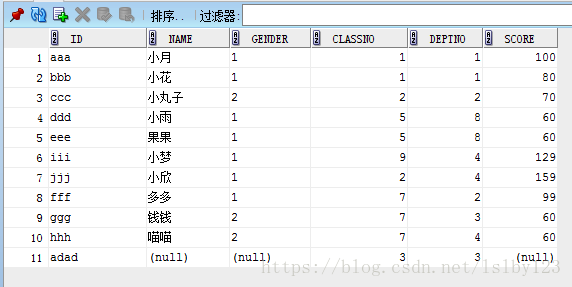
count:
--count (distinct|all)
select count(1) as count from student;--效率最高
select count(*) as count from student;
select count(distinct score) from student;
语句1结果:11
avg
--avg (distinct|all)
select avg(score) score from student;
select avg(distinct score) from student;
select classno,avg(score) score from student group by classno;
语句3输出结果:
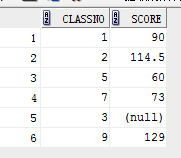
max
--max (distinct|all)
select max(score) from student;
select classno, max(score) score from student group by classno;
min
--min (distinct|all)
select min(score) from student;
select classno, min(score) score from student group by classno;
stddev(standard deviation)标准差
--stddev
select stddev(score) from student;
select classno, stddev(score) score from student group by classno;
sum
--sum
select sum(score) from student;
select classno, sum(score) score from student group by classno;
median--中位数
--median
select median(score) from student;
select classno, median(score) score from student group by classno;
案例1--学生选课
1. 创建表 stu(学生表),course(课程表),选课表(s_c)
--创建表
create table STU
(
id NUMBER not null,
name VARCHAR2(255)
) ;
create table COURSE
(
id NUMBER not null,
coursename VARCHAR2(255)
) ;
create table S_C
(
sid NUMBER,
cid NUMBER,
score NUMBER
);
2.插入数据
--插入数据
Insert into STU (ID,NAME) values (1,'wish');
Insert into STU (ID,NAME) values (2,'rain');
Insert into STU (ID,NAME) values (3,'july');
Insert into STU (ID,NAME) values (4,'joey');
Insert into COURSE (ID,COURSENAME) values (1,'math');
Insert into COURSE (ID,COURSENAME) values (2,'english');
Insert into COURSE (ID,COURSENAME) values (3,'Japanese');
Insert into COURSE (ID,COURSENAME) values (4,'chinese');
Insert into S_C (SID,CID,SCORE) values (1,1,80);
Insert into S_C (SID,CID,SCORE) values (1,2,90);
Insert into S_C (SID,CID,SCORE) values (2,4,100);
Insert into S_C (SID,CID,SCORE) values (4,4,90);
Insert into S_C (SID,CID,SCORE) values (4,1,100);
Insert into S_C (SID,CID,SCORE) values (4,3,80);
Insert into S_C (SID,CID,SCORE) values (4,2,80);
Insert into S_C (SID,CID,SCORE) values (2,1,90);
Insert into S_C (SID,CID,SCORE) values (2,4,100);
Insert into S_C (SID,CID,SCORE) values (3,1,60);
3.查询学生选课情况
with vt as
(select s.id,s.name,c.coursename,sc.score from stu s, course c, s_c sc where s.id=sc.sid and c.id=sc.cid)
select * from vt order by id;
结果:
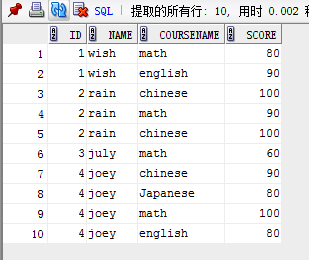
案例2--图书馆借阅
1.创建表: 图书(book),读者(reader),借阅(borrow)
--创建表 book
create table book(
bookId varchar2(30), --图书总编号
sortid varchar2(30), --分类号
bookname varchar2(100), --书名
author varchar2(30), --作者
publisher varchar2(100),--出版单位
price number(6,2) --价格
);
--创建表 reader
create table reader (
cardId varchar2(30), --借书证号
org varchar2(100), --单位
name varchar2(100), --姓名
gender varchar2(2), --性别
title varchar2(30), --职称
address varchar2(100) --地址
);
--创建表 borrow
create table borrow(
cardId varchar2(30), --借书证号
bookId varchar2(30), --图书总编号
borrowDate varchar2(30) --借阅时间
);
2.插入数据
--插入数据-book
insert into book (bookId,sortid,bookname,author,publisher,price)
values ('aaa','a1','gone with the wind','CA','renmin','103');
insert into book (bookId,sortid,bookname,author,publisher,price)
values ('bbb','a2','the little prince','CB','jixie','30');
insert into book (bookId,sortid,bookname,author,publisher,price)
values ('ccc','a3','the ordinary world','CC','renmin','130');
insert into book (bookId,sortid,bookname,author,publisher,price)
values ('ddd','a4','the little women','CA','dianzi','110');
--插入数据-reader
insert into reader(cardid, org, name,gender, title, address)
values ('xxx','A','wish','1','student','bupt');
insert into reader(cardid, org, name,gender, title, address)
values ('uuu','A','luna','1','student','bupt');
insert into reader(cardid, org, name,gender, title, address)
values ('vvv','B','harry','1','student','bupt');
insert into reader(cardid, org, name,gender, title, address)
values ('www','C','chander','2','professor','bupt');
insert into reader(cardid, org, name,gender, title, address)
values ('yyy','A','joey','2','student','bupt');
insert into reader(cardid, org, name,gender, title, address)
values ('zzz','B','richard','2','student','bupt');
insert into reader(cardid, org, name,gender, title, address)
values ('OOO','A','micheal','2','student','bupt');
insert into reader(cardid, org, name,gender, title, address)
values ('ppp','A','richal','2','student','bupt');
insert into reader(cardid, org, name,gender, title, address)
values ('abp','A','michal','2','student','bupt');
insert into reader(cardid, org, name,gender, title, address)
values ('ccp','A','mike','2','student','bupt');
--插入数据-borrow
insert into borrow(cardid,bookid,borrowdate) values('xxx','aaa','2014-4-29');
insert into borrow(cardid,bookid,borrowdate) values('xxx','bbb','2014-4-29');
insert into borrow(cardid,bookid,borrowdate) values('xxx','ccc','2014-4-28');
insert into borrow(cardid,bookid,borrowdate) values('yyy','ccc','2014-4-28');
insert into borrow(cardid,bookid,borrowdate) values('yyy','ddd','2014-4-27');
insert into borrow(cardid,bookid,borrowdate) values('yyy','aaa','2014-4-27');
insert into borrow(cardid,bookid,borrowdate) values('zzz','bbb','2014-4-28');
insert into borrow(cardid,bookid,borrowdate) values('zzz','ddd','2014-4-27');
insert into borrow(cardid,bookid,borrowdate) values('zzz','aaa','2014-4-27');
insert into borrow(cardid,bookid,borrowdate) values('uuu','bbb','2014-4-28');
insert into borrow(cardid,bookid,borrowdate) values('uuu','ddd','2014-4-27');
insert into borrow(cardid,bookid,borrowdate) values('uuu','aaa','2014-4-27');
insert into borrow(cardid,bookid,borrowdate) values('uuu','ccc','2014-4-26');
insert into borrow(cardid,bookid,borrowdate) values('vvv','bbb','2014-4-28');
insert into borrow(cardid,bookid,borrowdate) values('vvv','ddd','2014-4-27');
insert into borrow(cardid,bookid,borrowdate) values('www','aaa','2014-4-27');
insert into borrow(cardid,bookid,borrowdate) values('www','ccc','2014-4-26');
表信息如下:
book------> reader-------> borrow

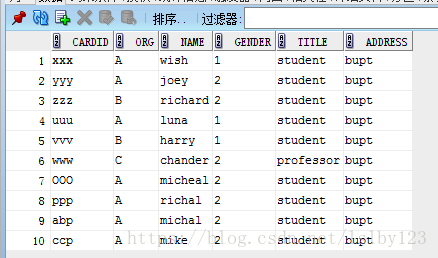
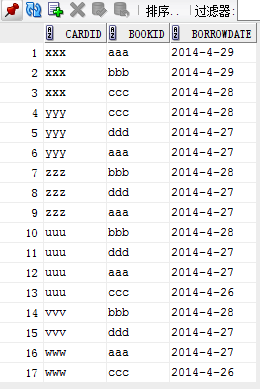
3. 查询A单位借阅图书的读者人数和人员详细信息
人数:
with vt1 as
(select cardid from reader where reader.org='A')
select count(1) from vt1 where exists (select cardid from borrow where borrow.cardid=vt1.cardid);

详细信息:
with vt1 as
(select cardid,name,org from reader where reader.org='A')
select cardid,name,org from vt1 where exists (select cardid from borrow where borrow.cardid=vt1.cardid);

4.查询借书证号尾字符为'p'的读者
select cardid, name, org from reader where cardid like '%p';
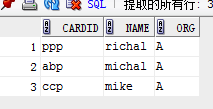
5. 查询名字以m开头的女性读者,‘1’显示为女,‘2’显示为男
select cardid, name, org,
case when gender='1' then '女' when gender='2' then '男' else '其他' end gender
from reader where name like 'm%';
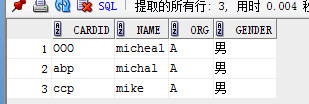
6. 2014年2-4月借过书的读者
1)查询满足条件的读者(仅包含cardid)--未去重
方式一:
select cardid, borrowdate from borrow where to_char(to_date(borrowdate,'yyyy-mm-dd'),'yyyy')='2014'
and to_char(to_date(borrowdate,'yyyy-mm-dd'),'mm')>='02'
and to_char(to_date(borrowdate,'yyyy-mm-dd'),'mm')<='04';
方式二:
select cardid, borrowdate from borrow where to_char(to_date(borrowdate,'yyyy-mm-dd'),'yyyy')='2014' --查询
and to_char(to_date(borrowdate,'yyyy-mm-dd'),'yyyy-mm')>='2014-02'
and to_char(to_date(borrowdate,'yyyy-mm-dd'),'yyyy-mm')<='2014-04';
方式三:
select cardid, borrowdate from borrow where to_date(borrowdate,'yyyy-mm-dd hh24:mi:ss') between
to_date('2014-02-01 00:00:00','yyyy-mm-dd hh24:mi:ss') and
to_date('2014-05-01 00:00:00','yyyy-mm-dd hh24:mi:ss');

2) 查询+去重
select distinct cardid from borrow where to_char(to_date(borrowdate,'yyyy-mm-dd'),'yyyy')='2014' --查询+去重
and to_char(to_date(borrowdate,'yyyy-mm-dd'),'yyyy-mm')>='2014-02'
and to_char(to_date(borrowdate,'yyyy-mm-dd'),'yyyy-mm')<='2014-04';
select distinct cardid from borrow where to_date(borrowdate,'yyyy-mm-dd hh24:mi:ss') between
to_date('2014-02-01 00:00:00','yyyy-mm-dd hh24:mi:ss') and
to_date('2014-05-01 00:00:00','yyyy-mm-dd hh24:mi:ss');
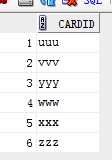
3)查询+去重+读者姓名等信息
with vt1 as
(select distinct cardid from borrow where to_char(to_date(borrowdate,'yyyy-mm-dd'),'yyyy')='2014'
and to_char(to_date(borrowdate,'yyyy-mm-dd'),'yyyy-mm')>='2014-02'
and to_char(to_date(borrowdate,'yyyy-mm-dd'),'yyyy-mm')<='2014-04')
select cardid, name,org from reader where exists (select cardid from vt1 where vt1.cardid=reader.cardid);
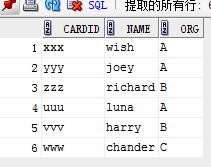
Oracle数据库常用语法的更多相关文章
- Oracle数据库常用的Sql语句整理
Oracle数据库常用的Sql语句整理 查看当前用户的缺省表空间 : select username,default_tablespace from user_users; 2.查看用户下所有的表 : ...
- oracle数据库常用查询一
oracle数据库常用查询一 sqlplus / as sysdba; 或sqlplus sys/密码 as sysdba;两者都是以sys登录.conn scott/tiger@orcl; conn ...
- ORACLE数据库常用查询二
ORACLE数据库常用查询 1.查看表空间对应数据文件情况: SQL MB,AUTOEXTENSIBLE FROM DBA_DATA_FILES; TABLESPACE_NAME FILE_NAME ...
- .Net 中读写Oracle数据库常用两种方式
.net中连接Oracle 的两种方式:OracleClient,OleDb转载 2015年04月24日 00:00:24 10820.Net 中读写Oracle数据库常用两种方式:OracleCli ...
- oracle数据库常用plsql语句
(一)oracle中常用的数据类型 (二)PL-sql基本语法 1.创建数据库表.删除数据库表 create table table1--创建表 ( field1 number(8), field2 ...
- Oracle数据库常用Sql语句大全
一,数据控制语句 (DML) 部分 1.INSERT (往数据表里插入记录的语句) INSERT INTO 表名(字段名1, 字段名2, ……) VALUES ( 值1, 值2, ……); INSE ...
- ORACLE数据库 常用命令和Sql常用语句
ORACLE 账号相关 如何获取表及权限 1.COPY表空间backup scottexp登录管理员账号system2.创建用户 create user han identified(认证) by m ...
- oracle数据库常用SQL语句(11.29更新)
笔者日常工作中常用到的sql语句,现总结如下,留作日后查看. 1.按照两列中的最大值取 ,只取两列其中的一列 SELECT * FROM t_doc T ORDER BY GREATEST(T.Loa ...
- Oracle数据库常用命令(持续更新)
1. 查询当前用户所有的表 select * from user_tables; 2. 查询当前用户能访问的表 select * from all_tables; 3. 获取表字段 select * ...
随机推荐
- EasyEarth三维可视化解决方案——智慧河长
EasyEarth—— 为河长装上“千里眼.顺风耳” 为各级河长办应急指挥.任务指派. 实绩考核提供快速直观的 高效.精准.智能化决策平台. 河长制背景 我国治水工作呈现出新老问题交织态势,河湖管理保 ...
- Linux命令及作用
uname -r :查看当前使用的Linux内核版本信息 cat /proc/cpuinfo:查看当前主机CPU型号,规格等信息 cat /proc/meminfo :查看当前主机内存信息 hostn ...
- 关于 Javascript 学习,有哪些好的博客或者网站推荐?
知乎社区:http://www.zhihu.com/question/19651401 Mozilla开发者网络社区:https://developer.mozilla.org/zh-CN/ moze ...
- 基于Hive的对BiliBili用户信息进行数据分析
用户表字段信息: 1.查出前1000位用户的用户名,关注数和粉丝数. 2.查询关注数大于100的用户的用户名和关注数. 3.查询粉丝数大于100的用户的用户名,粉丝数. 4.查询id为1000的用户的 ...
- hadoop综合
对CSV文件进行预处理生成无标题文本文件,将爬虫大作业产生的csv文件上传到HDFS 首先,我们需要在本地中创建一个/usr/local/bigdatacase/dataset文件夹,具体的步骤为: ...
- Jmeter工具功能介绍
可以去官方学习:http://jmeter.apache.org/ 1.可以修改语言 2.部分图标功能 新建 打开一个jmeter脚本 保存一个jmeter脚本 剪切 复制 粘贴 展开目录树 收起目录 ...
- Netty 读写检测机制(心跳)
一.创建服务端 1.MyServer 类 public class MyServer { public static void main(String[] args) throws Exception ...
- Spring的异步方法
先把longTimeMethod 封装到Spring的异步方法中,这个异步方法的返回值是Future的实例.这个方法一定要写在Spring管理的类中,注意注解@Async. @Service publ ...
- 执行buildman --fetch-arch arm提示"urllib2.URLError: <urlopen error [SSL: CERTIFICATE_VERIFY_FAILED] certificate verify failed (_ssl.c:581)>"如何处理?
答: 在uboot源码的tools/buildman/toolchain.py中取消证书验证,修改内容如下: diff --git a/tools/buildman/toolchain.py b/to ...
- pycharm设置代码行的长度为79字符(PEP8)
pycharm设置代码行的长度为79字符
